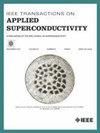MgB2超导磁体在0.3 T MRI系统中淬火的数值模拟
IF 1.8
3区 物理与天体物理
Q3 ENGINEERING, ELECTRICAL & ELECTRONIC
引用次数: 0
摘要
本文研究了二硼化镁(MgB2)超导磁体在磁共振成像系统中的淬火特性。磁体产生0.3 T的中心磁场,工作在20k下,电流为90a,存储能量为26.25 kJ。基于有限差分法建立了MgB2磁体的电磁-热耦合多物理场猝灭模型。为了准确地描述磁体的猝灭行为,采用了适用于低n值的电流共享模型。采用改进的积分法求解磁场方程,提高了计算效率。为探索恒流模式下磁体的自保护特性,研究了MgB2导线内铜含量和铜纯度对磁体猝灭特性的影响。结果表明:淬火过程中峰值温度和峰值电压随铜含量的增加而降低;重要的是,当Cu含量超过特定阈值时,该磁铁具有自我保护能力。同时,增加Cu稳定剂的纯度可以提高峰值淬火温度,降低峰值电压。这是因为高纯度铜倾向于将淬火过程限制在较小的空间区域内。此外,针对MgB2超导磁体的驱动工作模式,设计了一种基于自卸式电阻器的超冷保护方案。仿真结果表明,该保护方案有效地防止了磁体在淬火过程中的损坏。本文章由计算机程序翻译,如有差异,请以英文原文为准。
Numerical Simulation of Quench of MgB2 Superconducting Magnet in 0.3 T MRI System
In this article, the quench characteristics of the magnesium diboride (MgB2) superconducting magnet in a magnetic resonance imaging system are studied. The magnet generates a central magnetic field of 0.3 T, operates at 20 K with a current of 90 A, and stores an energy of 26.25 kJ. A coupled electromagnetic-thermal multiphysics quench model for the MgB2 magnet was established based on the finite difference method. To accurately represent magnet quench behavior, a current-sharing model applicable for low n-values was employed. Computational efficiency was enhanced by utilizing a modified integral method for solving the magnetic field equations. To explore the self-protection characteristics of a magnet operating in persistent current mode, the influence of copper (Cu) content and Cu purity grade within the MgB2 wire on the quench characteristics of the magnet was studied. The results reveal that both the peak temperature and peak voltage during a quench event decrease with increasing Cu content within the MgB2 wire. Crucially, self-protection capability was achieved for this magnet when the Cu content exceeded a specific threshold. At the same time, increasing the purity of the Cu stabilizer was found to elevate the peak quench temperature and reduce the peak voltage. This occurs because high-purity Cu tends to confine the quench process within a smaller spatial region. Furthermore, a quench protection scheme based on a dump resistor was specifically designed for the MgB2 superconducting magnet operating in driven mode. Simulation results confirm that this protection scheme effectively prevents damage to the magnet during quench.
求助全文
通过发布文献求助,成功后即可免费获取论文全文。
去求助
来源期刊

IEEE Transactions on Applied Superconductivity
工程技术-工程:电子与电气
CiteScore
3.50
自引率
33.30%
发文量
650
审稿时长
2.3 months
期刊介绍:
IEEE Transactions on Applied Superconductivity (TAS) contains articles on the applications of superconductivity and other relevant technology. Electronic applications include analog and digital circuits employing thin films and active devices such as Josephson junctions. Large scale applications include magnets for power applications such as motors and generators, for magnetic resonance, for accelerators, and cable applications such as power transmission.
 求助内容:
求助内容: 应助结果提醒方式:
应助结果提醒方式:


